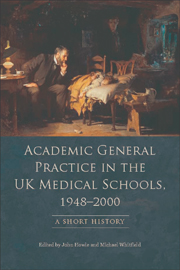Book contents
- Frontmatter
- Contents
- Preface
- Acknowledgements
- Abbreviations
- Timeline
- Introduction
- Dedication
- 1 The University of Aberdeen
- 2 The University of Dundee
- 3 The University of Edinburgh
- 4 The University of Glasgow
- 5 The Cardiff University School of Medicine
- 6 Academic General Practice in Ireland
- 7 The University of Birmingham
- 8 The University of Bristol
- 9 The University of Cambridge
- 10 The University of Exeter
- 11 The University of Leeds
- 12 The University of Leicester
- 13 The University of Liverpool
- 14 The University of Manchester
- 15 The University of Newcastle
- 16 The University of Nottingham
- 17 The University of Oxford
- 18 The University of Sheffield
- 19 The University of Southampton
- 20 The London Medical Schools
- 21 The University of St Andrews
- Appendix 1 Primary Care in the New Medical Schools
- Appendix 2 The SIFT/ACT Negotiations
- Appendix 3 An Overview
- Appendix 4 And Finally…
- Index
9 - The University of Cambridge
Published online by Cambridge University Press: 05 August 2013
- Frontmatter
- Contents
- Preface
- Acknowledgements
- Abbreviations
- Timeline
- Introduction
- Dedication
- 1 The University of Aberdeen
- 2 The University of Dundee
- 3 The University of Edinburgh
- 4 The University of Glasgow
- 5 The Cardiff University School of Medicine
- 6 Academic General Practice in Ireland
- 7 The University of Birmingham
- 8 The University of Bristol
- 9 The University of Cambridge
- 10 The University of Exeter
- 11 The University of Leeds
- 12 The University of Leicester
- 13 The University of Liverpool
- 14 The University of Manchester
- 15 The University of Newcastle
- 16 The University of Nottingham
- 17 The University of Oxford
- 18 The University of Sheffield
- 19 The University of Southampton
- 20 The London Medical Schools
- 21 The University of St Andrews
- Appendix 1 Primary Care in the New Medical Schools
- Appendix 2 The SIFT/ACT Negotiations
- Appendix 3 An Overview
- Appendix 4 And Finally…
- Index
Summary
Medicine has been studied in Cambridge since 1318, but it was not until the time of John Butterfield (Regius 1976–1987) and Keith Peters (Regius 1987–2005) that the foundation chairs of community medicine (1977) and general practice (1996) were established. Butterfield led the establishment of the school of clinical medicine (1976), and Peters the transformation of the school into a world leading centre for medical research.
The path to realising the academic aspirations of general practice led uphill. The combined efforts of postgraduate general practice educators, the RHA, Royal Colleges and local practitioners took twenty years to establish a chair of general practice.
In the 1970s the Royal Commission on Medical Education strongly recommended including general practice in the clinical curriculum, recognising it as a specialty and proposing structured general practice postgraduate training and senior academic appointments for general practice undergraduate teachers. In East Anglia, regional and associate general practice advisers were appointed in the postgraduate Dean's office, providing the first formal links between general practice education, the RHA and the university.
Bernard Reiss (the first regional adviser from 1973–1976) and Ian Tait (associate), held these key link positions. Having previously introduced pre-clinical student visits to local general practices they pushed for clinical teaching appointments and in 1976 hoped for a general practice undergraduate teaching and research department. The university responded by creating the post of director of studies in general practice.
- Type
- Chapter
- Information
- Academic General Practice in the UK Medical Schools, 1948-2000A Short History, pp. 40 - 46Publisher: Edinburgh University PressPrint publication year: 2011



